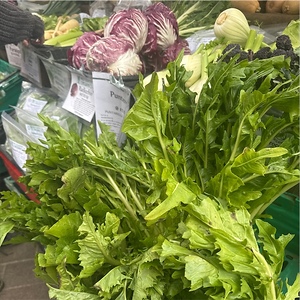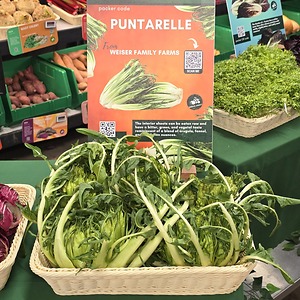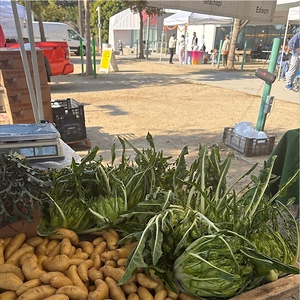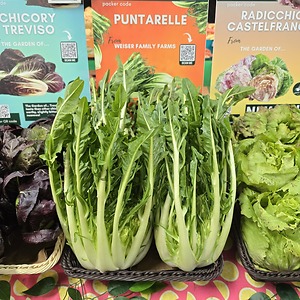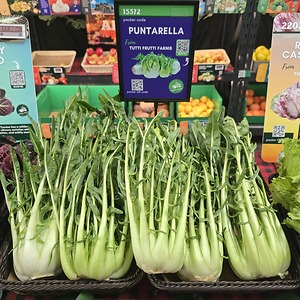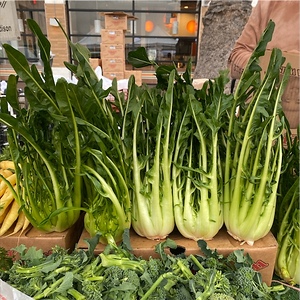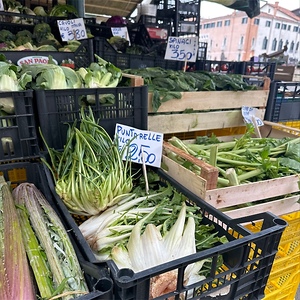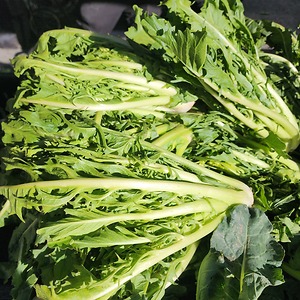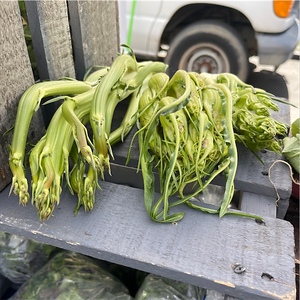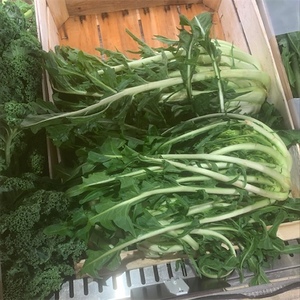

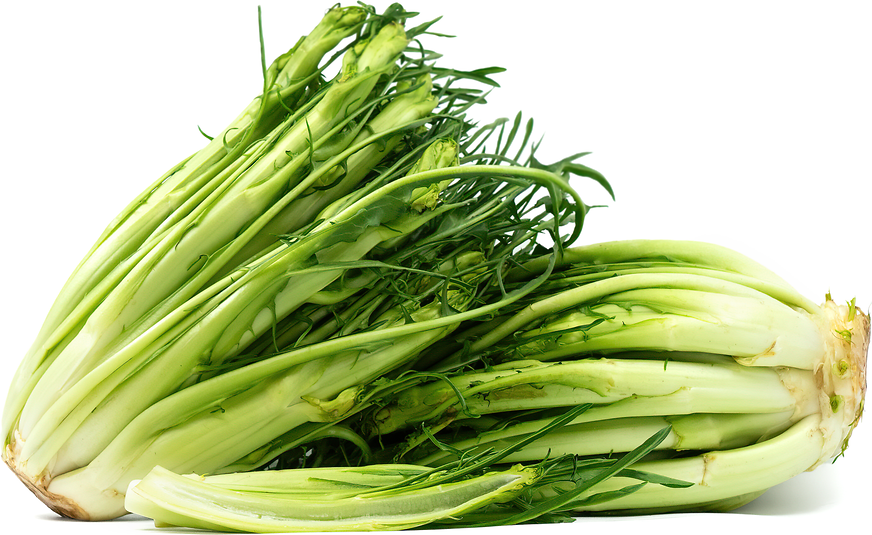
Puntarelle
Estimated Inventory, 6 ct : 0
Description/Taste
Puntarelle varies in size, shape, and appearance, depending on the variety, but generally has an elongated head comprised of many tightly layered shoots with slender, pointed leaves. The heads range from 12 to 40 centimeters in length, and each shoot is connected to a central, singular base. One head may contain as many as twenty shoots, and the shoots are mainly made up of thick, white to pale green, fleshy shoots. The exterior shoots average 5 to 7 centimeters in diameter and have a rubbery, semi-smooth, and faintly glossy exterior. When snapped in half, the shoots reveal a hollow center and a thin ring of crisp, aqueous, and striated pale green to white flesh. The shoots also bear serrated, tapered, and slender, dark green leaves that are textured and have a deeply veined nature. The interior, gnarled shoots are the most prized portion of the heads. These shoots sometimes resemble oversized, clustered asparagus and are referred to as thalli. The entire chicory head is edible raw or cooked, but the exterior shoots and leaves are typically cooked to reduce their bitter pungency. The interior shoots can be eaten raw and have a bitter, green, and vegetal taste reminiscent of a blend of arugula, fennel, and dandelion nuances.
Seasons/Availability
Puntarelle is harvested as early as the late fall, depending on the climate and growing conditions, and is gathered through mid-spring. In Italy, the tender inner shoots have a peak culinary season from February to April.
Current Facts
Puntarelle, botanically classified as Cichorium intybus, is a descriptor for the young, crisp inner shoots of Catalonia chicory belonging to the Asteraceae family. The name Puntarelle roughly translates from Italian to mean “little points” and is a term that describes only part of the Catalonia chicory plant used in various raw and cooked culinary preparations in Italy. Catalonia chicory is a type of loose-leafed chicory, and there are several varieties generally sold under the Catalonia chicory or Puntarelle name. Puntarelle de Geata is an elongated variety with tapered shoots, typically grown in the regions of Gaeta, Formia, and Fondi in Italy, while Puntarelle de Galantina is more compact and is from Galatina and Molfetta. Some varieties will also curl when sliced and immersed in ice water, while other varieties will not, based on the shoot’s shape. Puntarelle is the plural form of Puntarella, and the chicory, in general, is also known as Cicoria Asparago, meaning “Asparagus chicory,” Roman chicory, Catalonia chicory, Catalogna spigata, and Ciorcia di Catalogna. Catalonia chicory is picked when it is still young, crisp, and tender, and the heads are sold whole or cleaned and prepped in fresh markets as a seasonal culinary ingredient. Puntarelle is a popular ingredient sold throughout Rome and the rest of the Lazio region, and the shoots are served raw or cooked in traditional recipes, treasured for their bitter, fresh, and green flavor.
Nutritional Value
Puntarelle is a source of fiber to regulate the digestive tract, calcium to build strong bones and teeth, and vitamin C to boost the immune system. The shoots and young leaves also provide some iron to develop the protein hemoglobin for oxygen transport through the bloodstream, vitamin A to maintain healthy organ functioning, potassium to balance fluid levels within the body, and phosphorus to repair cell tissues. In Ancient Greek and Roman medicines, chicory was viewed as a natural diuretic consumed to clean the liver. The shoots and leaves were typically served between dishes during religious celebrations as a palate cleanser and a method to allow the stomach to rest between courses, increasing digestion.
Applications
Catalonia chicory has a bitter, green, and vegetal taste suited for raw and cooked preparations. In Italy, when Puntarelle is listed on a menu, it mainly refers to a salad-like dish also known as Puntarelle Alla Romana. The salad is comprised of sliced Puntarelle shoots that have been prepped, soaked in ice water, and then tossed in a dressing used to mellow the shoot’s sharp nature. Traditionally, the dressing contains anchovies, garlic, olive oil, salt, lemon juice, red or white wine vinegar, and herbs, but it can also be made with capers or chopped olives to balance the bitterness. Puntarelle Alla Romana has a snappy, crisp, and slightly chewy consistency, and the rich dressing creates a complex, bright, and savory dish. It is important to note that all parts of the Catalonia chicory head are traditionally used in Italian cooking. The inner shoots are used for Puntarelle, but the exterior leaves and sprouts are cooked to mellow their bitterness and combined with aromatics in main and side dishes. Catalonia chicory can be sauteed in chile peppers, garlic, lemon juice, oil, or anchovies and tossed into pasta, cooked and served with eggs, boiled and drizzled in olive oil, lemon, and salt as a simple side, or steamed. The exterior shoots can also be braised, blanched in salt water, or cooked and mixed into rice and grain-based recipes. The leaves are a popular addition to soups and beans, or they are added to savory pies. Catalonia chicory pairs well with mushrooms, artichokes, olives, pumpkin, herbs including basil, mint, and oregano, legumes, salami, prosciutto, dried fruits, and soft cheeses. Whole, unwashed Catalonia chicory heads will keep for 2 to 3 days when stored in the refrigerator. Washed and cleaned shoots will keep 1 to 2 days when stored in a sealed container with a paper towel in the fridge.
Ethnic/Cultural Info
Puntarelle is a seasonal delicacy traditionally cleaned and prepared fresh throughout local markets in Rome. The fleshy stalks are occasionally sold whole for chefs and home cooks seeking to prepare their own recipes, but the most popular method of purchase is created by vendors. Roman market vendors take pride in offering their customers healthy, prepped, and ready-to-eat ingredients, and purchasing ingredients for home cooking is more about the relationship between the vendor and the cook than the transaction. Vendors often offer suggestions and recipes for inquiring customers, and Puntarelle is proudly displayed when in season as a choice ingredient. The chicory’s heads are stripped, cleaned, and separated into individual stalks, and each stalk is pressed through a wire cutter known as taglia puntarella. This wire cutter is comprised of metal wire strung across a small wooden frame, and this tool is unique to Puntarelle. Taglia puntarella was originally designed to slice the stalks into thin, even strips. Once the stalks are passed through the cutter, the thin slices are immersed in ice water to help remove bitterness and preserve the crispness of the stalk. Some varieties of Puntarelle may curl in the ice water, while others remain straight. The prepped Puntarelle is sold in bags, ready to be consumed, and the fresh greens are a favored light dish served at home and restaurants throughout Rome in the late winter.
Geography/History
Catalonia chicory is thought to be a descendant of wild chicory plants native to regions of Western Asia, Europe, and North Africa. Much of the variety’s development is unknown, and some scientists hypothesize that it was created over time through selective breeding to produce plants with a crisp texture. Historically, chicory was used medicinally among the Greeks and the Romans, and later on, the stalks and greens were utilized in various raw and cooked culinary preparations. Catalonia chicory is a cool-season crop that thrives in temperate climates and is commonly found throughout the regions of Lazio, Puglia, and Campania in Italy. In Lazio, the inner stalks of the chicory were named Puntarelle and became a well-known ingredient in a seasonal winter salad, especially in Rome. Today, Puntarelle has expanded beyond Lazio, Puglia, and Campania and is now grown in other areas of Southern and Northern Italy. Puntarelle is also being cultivated on a small scale in other European countries, notably Germany and Switzerland, and in the United States as a seasonal delicacy. When in season, Puntarelle is sold whole in fresh heads or sliced and soaked in ice water throughout local markets in Italy. The Puntarelle featured in the photograph above was sourced through a fresh market in Rome, Italy.
Recipe Ideas
Recipes that include Puntarelle. One



